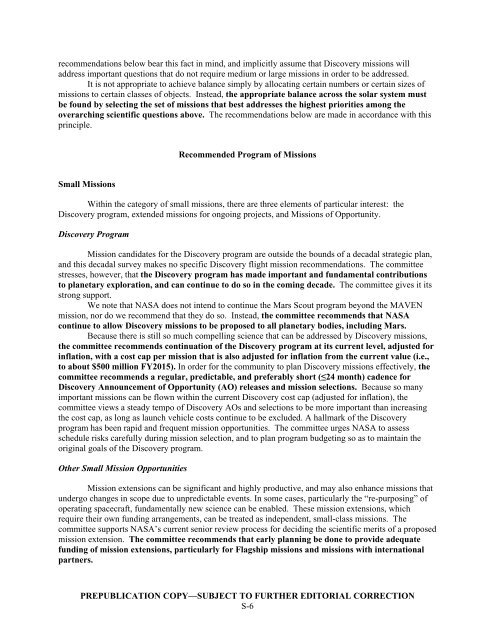Vision and Voyages for Planetary Science in the - Solar System ...
Vision and Voyages for Planetary Science in the - Solar System ...
Vision and Voyages for Planetary Science in the - Solar System ...
Create successful ePaper yourself
Turn your PDF publications into a flip-book with our unique Google optimized e-Paper software.
ecommendations below bear this fact <strong>in</strong> m<strong>in</strong>d, <strong>and</strong> implicitly assume that Discovery missions will<br />
address important questions that do not require medium or large missions <strong>in</strong> order to be addressed.<br />
It is not appropriate to achieve balance simply by allocat<strong>in</strong>g certa<strong>in</strong> numbers or certa<strong>in</strong> sizes of<br />
missions to certa<strong>in</strong> classes of objects. Instead, <strong>the</strong> appropriate balance across <strong>the</strong> solar system must<br />
be found by select<strong>in</strong>g <strong>the</strong> set of missions that best addresses <strong>the</strong> highest priorities among <strong>the</strong><br />
overarch<strong>in</strong>g scientific questions above. The recommendations below are made <strong>in</strong> accordance with this<br />
pr<strong>in</strong>ciple.<br />
Small Missions<br />
Recommended Program of Missions<br />
With<strong>in</strong> <strong>the</strong> category of small missions, <strong>the</strong>re are three elements of particular <strong>in</strong>terest: <strong>the</strong><br />
Discovery program, extended missions <strong>for</strong> ongo<strong>in</strong>g projects, <strong>and</strong> Missions of Opportunity.<br />
Discovery Program<br />
Mission c<strong>and</strong>idates <strong>for</strong> <strong>the</strong> Discovery program are outside <strong>the</strong> bounds of a decadal strategic plan,<br />
<strong>and</strong> this decadal survey makes no specific Discovery flight mission recommendations. The committee<br />
stresses, however, that <strong>the</strong> Discovery program has made important <strong>and</strong> fundamental contributions<br />
to planetary exploration, <strong>and</strong> can cont<strong>in</strong>ue to do so <strong>in</strong> <strong>the</strong> com<strong>in</strong>g decade. The committee gives it its<br />
strong support.<br />
We note that NASA does not <strong>in</strong>tend to cont<strong>in</strong>ue <strong>the</strong> Mars Scout program beyond <strong>the</strong> MAVEN<br />
mission, nor do we recommend that <strong>the</strong>y do so. Instead, <strong>the</strong> committee recommends that NASA<br />
cont<strong>in</strong>ue to allow Discovery missions to be proposed to all planetary bodies, <strong>in</strong>clud<strong>in</strong>g Mars.<br />
Because <strong>the</strong>re is still so much compell<strong>in</strong>g science that can be addressed by Discovery missions,<br />
<strong>the</strong> committee recommends cont<strong>in</strong>uation of <strong>the</strong> Discovery program at its current level, adjusted <strong>for</strong><br />
<strong>in</strong>flation, with a cost cap per mission that is also adjusted <strong>for</strong> <strong>in</strong>flation from <strong>the</strong> current value (i.e.,<br />
to about $500 million FY2015). In order <strong>for</strong> <strong>the</strong> community to plan Discovery missions effectively, <strong>the</strong><br />
committee recommends a regular, predictable, <strong>and</strong> preferably short (≤24 month) cadence <strong>for</strong><br />
Discovery Announcement of Opportunity (AO) releases <strong>and</strong> mission selections. Because so many<br />
important missions can be flown with<strong>in</strong> <strong>the</strong> current Discovery cost cap (adjusted <strong>for</strong> <strong>in</strong>flation), <strong>the</strong><br />
committee views a steady tempo of Discovery AOs <strong>and</strong> selections to be more important than <strong>in</strong>creas<strong>in</strong>g<br />
<strong>the</strong> cost cap, as long as launch vehicle costs cont<strong>in</strong>ue to be excluded. A hallmark of <strong>the</strong> Discovery<br />
program has been rapid <strong>and</strong> frequent mission opportunities. The committee urges NASA to assess<br />
schedule risks carefully dur<strong>in</strong>g mission selection, <strong>and</strong> to plan program budget<strong>in</strong>g so as to ma<strong>in</strong>ta<strong>in</strong> <strong>the</strong><br />
orig<strong>in</strong>al goals of <strong>the</strong> Discovery program.<br />
O<strong>the</strong>r Small Mission Opportunities<br />
Mission extensions can be significant <strong>and</strong> highly productive, <strong>and</strong> may also enhance missions that<br />
undergo changes <strong>in</strong> scope due to unpredictable events. In some cases, particularly <strong>the</strong> “re-purpos<strong>in</strong>g” of<br />
operat<strong>in</strong>g spacecraft, fundamentally new science can be enabled. These mission extensions, which<br />
require <strong>the</strong>ir own fund<strong>in</strong>g arrangements, can be treated as <strong>in</strong>dependent, small-class missions. The<br />
committee supports NASA’s current senior review process <strong>for</strong> decid<strong>in</strong>g <strong>the</strong> scientific merits of a proposed<br />
mission extension. The committee recommends that early plann<strong>in</strong>g be done to provide adequate<br />
fund<strong>in</strong>g of mission extensions, particularly <strong>for</strong> Flagship missions <strong>and</strong> missions with <strong>in</strong>ternational<br />
partners.<br />
PREPUBLICATION COPY—SUBJECT TO FURTHER EDITORIAL CORRECTION<br />
S-6











